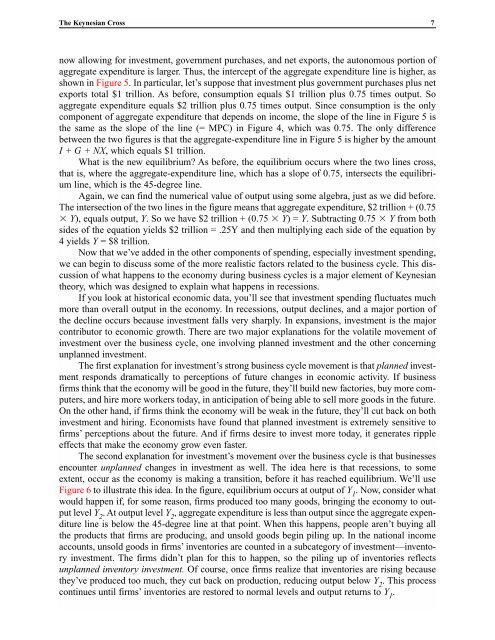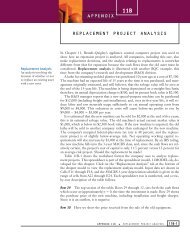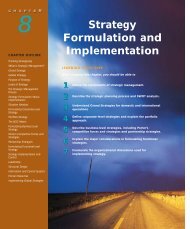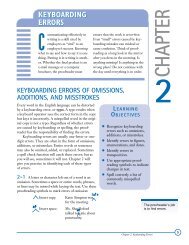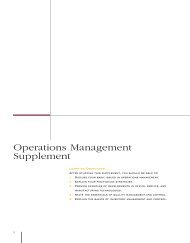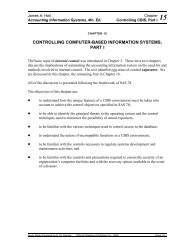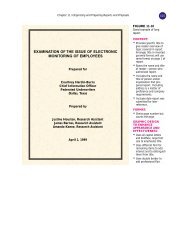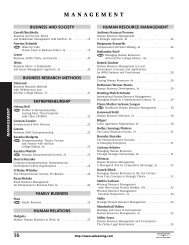The Keynesian Cross
The Keynesian Cross
The Keynesian Cross
You also want an ePaper? Increase the reach of your titles
YUMPU automatically turns print PDFs into web optimized ePapers that Google loves.
<strong>The</strong> <strong>Keynesian</strong> <strong>Cross</strong> 7<br />
now allowing for investment, government purchases, and net exports, the autonomous portion of<br />
aggregate expenditure is larger. Thus, the intercept of the aggregate expenditure line is higher, as<br />
shown in Figure 5. In particular, let’s suppose that investment plus government purchases plus net<br />
exports total $1 trillion. As before, consumption equals $1 trillion plus 0.75 times output. So<br />
aggregate expenditure equals $2 trillion plus 0.75 times output. Since consumption is the only<br />
component of aggregate expenditure that depends on income, the slope of the line in Figure 5 is<br />
the same as the slope of the line (= MPC) in Figure 4, which was 0.75. <strong>The</strong> only difference<br />
between the two figures is that the aggregate-expenditure line in Figure 5 is higher by the amount<br />
I + G + NX, which equals $1 trillion.<br />
What is the new equilibrium? As before, the equilibrium occurs where the two lines cross,<br />
that is, where the aggregate-expenditure line, which has a slope of 0.75, intersects the equilibrium<br />
line, which is the 45-degree line.<br />
Again, we can find the numerical value of output using some algebra, just as we did before.<br />
<strong>The</strong> intersection of the two lines in the figure means that aggregate expenditure, $2 trillion + (0.75<br />
Y), equals output, Y. So we have $2 trillion + (0.75 Y) = Y. Subtracting 0.75 Y from both<br />
sides of the equation yields $2 trillion = .25Y and then multiplying each side of the equation by<br />
4 yields Y = $8 trillion.<br />
Now that we’ve added in the other components of spending, especially investment spending,<br />
we can begin to discuss some of the more realistic factors related to the business cycle. This discussion<br />
of what happens to the economy during business cycles is a major element of <strong>Keynesian</strong><br />
theory, which was designed to explain what happens in recessions.<br />
If you look at historical economic data, you’ll see that investment spending fluctuates much<br />
more than overall output in the economy. In recessions, output declines, and a major portion of<br />
the decline occurs because investment falls very sharply. In expansions, investment is the major<br />
contributor to economic growth. <strong>The</strong>re are two major explanations for the volatile movement of<br />
investment over the business cycle, one involving planned investment and the other concerning<br />
unplanned investment.<br />
<strong>The</strong> first explanation for investment’s strong business cycle movement is that planned investment<br />
responds dramatically to perceptions of future changes in economic activity. If business<br />
firms think that the economy will be good in the future, they’ll build new factories, buy more computers,<br />
and hire more workers today, in anticipation of being able to sell more goods in the future.<br />
On the other hand, if firms think the economy will be weak in the future, they’ll cut back on both<br />
investment and hiring. Economists have found that planned investment is extremely sensitive to<br />
firms’ perceptions about the future. And if firms desire to invest more today, it generates ripple<br />
effects that make the economy grow even faster.<br />
<strong>The</strong> second explanation for investment’s movement over the business cycle is that businesses<br />
encounter unplanned changes in investment as well. <strong>The</strong> idea here is that recessions, to some<br />
extent, occur as the economy is making a transition, before it has reached equilibrium. We’ll use<br />
Figure 6 to illustrate this idea. In the figure, equilibrium occurs at output of Y 1 . Now, consider what<br />
would happen if, for some reason, firms produced too many goods, bringing the economy to output<br />
level Y 2 . At output level Y 2 , aggregate expenditure is less than output since the aggregate expenditure<br />
line is below the 45-degree line at that point. When this happens, people aren’t buying all<br />
the products that firms are producing, and unsold goods begin piling up. In the national income<br />
accounts, unsold goods in firms’ inventories are counted in a subcategory of investment—inventory<br />
investment. <strong>The</strong> firms didn’t plan for this to happen, so the piling up of inventories reflects<br />
unplanned inventory investment. Of course, once firms realize that inventories are rising because<br />
they’ve produced too much, they cut back on production, reducing output below Y 2 . This process<br />
continues until firms’ inventories are restored to normal levels and output returns to Y 1 .


